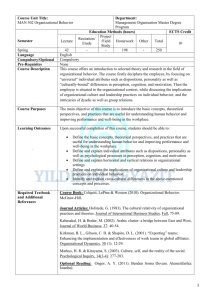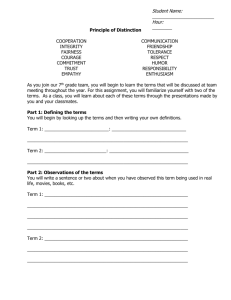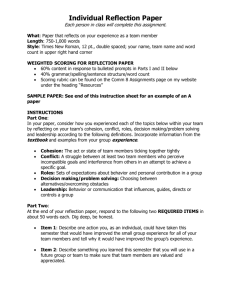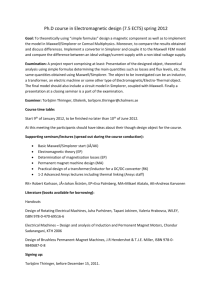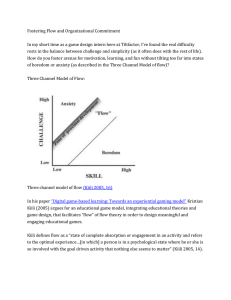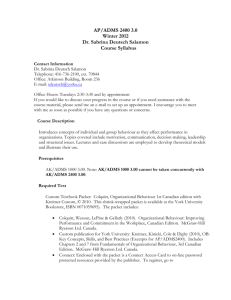Organizational Behavior: A Study on Managers, Employees, and
advertisement
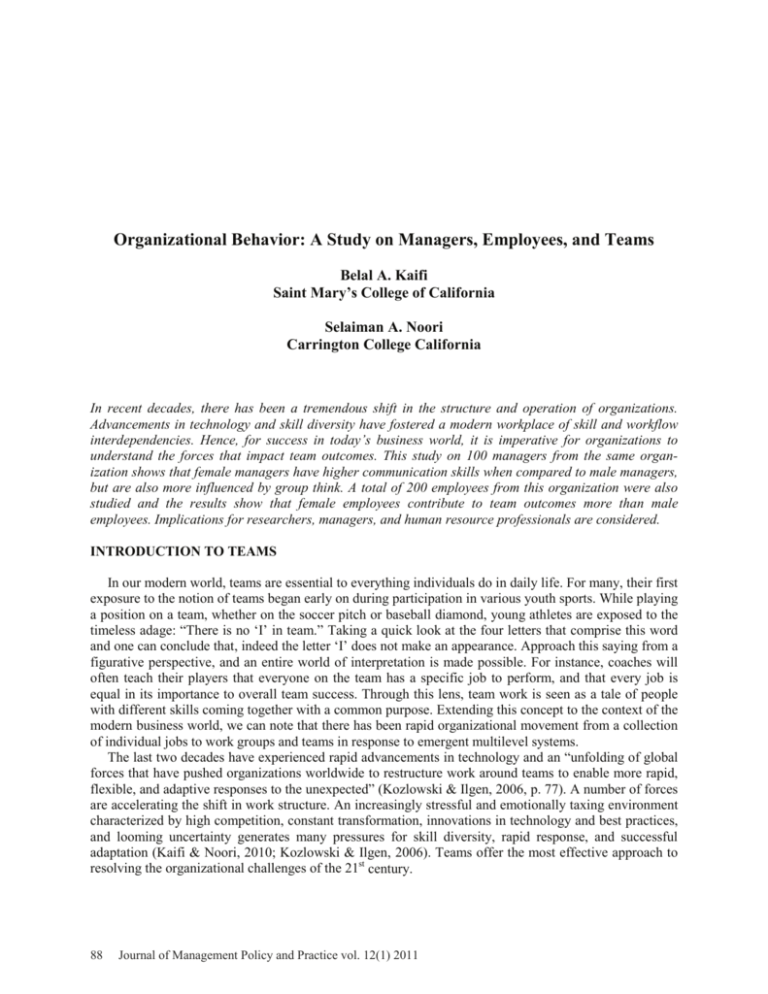
Organizational Behavior: A Study on Managers, Employees, and Teams Belal A. Kaifi Saint Mary’s College of California Selaiman A. Noori Carrington College California In recent decades, there has been a tremendous shift in the structure and operation of organizations. Advancements in technology and skill diversity have fostered a modern workplace of skill and workflow interdependencies. Hence, for success in today’s business world, it is imperative for organizations to understand the forces that impact team outcomes. This study on 100 managers from the same organization shows that female managers have higher communication skills when compared to male managers, but are also more influenced by group think. A total of 200 employees from this organization were also studied and the results show that female employees contribute to team outcomes more than male employees. Implications for researchers, managers, and human resource professionals are considered. INTRODUCTION TO TEAMS In our modern world, teams are essential to everything individuals do in daily life. For many, their first exposure to the notion of teams began early on during participation in various youth sports. While playing a position on a team, whether on the soccer pitch or baseball diamond, young athletes are exposed to the timeless adage: “There is no ‘I’ in team.” Taking a quick look at the four letters that comprise this word and one can conclude that, indeed the letter ‘I’ does not make an appearance. Approach this saying from a figurative perspective, and an entire world of interpretation is made possible. For instance, coaches will often teach their players that everyone on the team has a specific job to perform, and that every job is equal in its importance to overall team success. Through this lens, team work is seen as a tale of people with different skills coming together with a common purpose. Extending this concept to the context of the modern business world, we can note that there has been rapid organizational movement from a collection of individual jobs to work groups and teams in response to emergent multilevel systems. The last two decades have experienced rapid advancements in technology and an “unfolding of global forces that have pushed organizations worldwide to restructure work around teams to enable more rapid, flexible, and adaptive responses to the unexpected” (Kozlowski & Ilgen, 2006, p. 77). A number of forces are accelerating the shift in work structure. An increasingly stressful and emotionally taxing environment characterized by high competition, constant transformation, innovations in technology and best practices, and looming uncertainty generates many pressures for skill diversity, rapid response, and successful adaptation (Kaifi & Noori, 2010; Kozlowski & Ilgen, 2006). Teams offer the most effective approach to resolving the organizational challenges of the 21st century. 88 Journal of Management Policy and Practice vol. 12(1) 2011 LITERATURE REVIEW Organizational behavior (OB) is a field of study devoted to recognizing, explaining, and eventually developing the attitudes and behaviors of people (individual and group) within organizations. Organizational behavior is based on scientific knowledge and applied practice. According to Kaifi (2010), the “RED Analysis” can be applied by practitioners and researchers for understanding organizational behavior issues: R- Recognize E- Explain D- Develop Diagnosing organizational behavior is an ongoing cycle of recognizing areas of concerns, explaining the short-term and long-term implications of each behavior, and continuously developing best practices and strategies that can help an organization transform into a robust, high-performing, and dynamic entity. It must be mentioned that organizations need strong managers who are capable of controlling the organization’s behavior. Managers who understand human resource management and strategic management are able to influence specific behaviors that help shape the culture of an organization. Influencing specific behaviors in an organization can be a difficult task to undertake for a number of reasons. The most obvious reason is that humans are unpredictable and have unique attitudes and perspectives. When they enter the workforce, they also bring their expectations and experiences to the workforce which many not correlate with the organization’s mission. This creates an instant dilemma that can be contagious to others. Controlling such organizational ills is a battle with no end, which accurately explains why the study of organizational behavior is so important. Being able to diagnose those issues and responding with well-formulated solutions is what many organizational behavior researchers and managers strive for. The three primary outcomes of organizational behavior are job performance, organizational commitment, and quality of work life (QWL). Although organizational behavior is an applied discipline, students are not “trained in organizational behavior. Rather, they are educated in organizational behavior and are a co-producer in learning” (Nelson & Quick, 2011, p. 25). The study of organizational behavior requires a rudimentary understanding of psychology, anthropology, sociology, philosophy, and axiology. From a psychological perspective, human behaviors and mental processes dictate how organizations perform; from an anthropological perspective, the culture, language, and beliefs of each individual dictate how organizations perform; from a sociological perspective, the development of human and social behavior dictate how organizations function; from a philosophical perspective, the morals and ethics of an individual dictate how organizations function; and from an axiological perspective, an individual’s values dictate how organizations function. Other disciplines (e.g., economics, engineering, or social psychology) may be applied to organizational behavior, as well. For example, in 1776, Adam Smith published The Wealth of Nations where he explained the economic advantages of “division of labor” (breakdown of jobs into narrow and repetitive tasks) in organizations. This diversity in organizational behavior allows researchers to investigate new avenues for dealing with organizational issues from different perspectives and angles. Many organizational behavior researchers believe that organizations are systems. The two basic types of organization systems are closed and open. Many contemporary organizations are open systems that interact with their environment. A closed system does not depend on its environment and can function without the consumption of external resources. An open system must interact with the environment to survive by consuming and exporting resources to the environment. In an open and closed organization system, the people are the human resources of the organization who have specific skills, the purpose of the organization is the mission, vision, and goal for existing, the plan of the organization is the strategy, competitive advantages, and objectives of the organization, and the priorities of the organization are what drive the organization to thrive or excel, which in most cases is revenue. Schwartz, Jones, & McCarty (2010) explain, “No matter how much value we produce today—whether it’s measured in dollars or sales Journal of Management Policy and Practice vol. 12(1) 2011 89 or goods or widgets—it’s never enough” (p. 3). The four P’s to understanding organizations as systems (Kaifi, 2010) is depicted in Figure 1: FIGURE 1 ORGANIZATIONS ARE SYSTEMS Priorities People Plan Purpose An open organization system functions both internally and externally. The external system has an impact on the internal system and vice versa. For example, the actions of customers (externally) affect the organization and the behavior of people (internally) at work. “Today, when we describe organizations as systems, we mean open systems. An organization takes inputs (resources) from the environment and transforms or processes these resources into outputs that are distributed in the environment” (Robbins & Coulter, 2005, p. 35). An example of an open system organization is a college or university that transforms students into highly-skilled workers that become a part of their environment. A closed organization system (which is becoming less common) does not interact with its environment and as a result is disconnected to the real-world. Some examples of closed system organizations are the regional armies of the People’s Republic of China (Shambaugh, 1991), spiritual cults (e.g., Waco), Camp X-Ray at Guantanamo Bay, and prison systems (Fong, Vogel, & Buentello, 1995). With globalization, technological advancements, and unlimited competition, organizations are more likely to become open systems and depend more on their environments. As a result, organizations are investing in teams. TEAMS Simply defined, a team is composed of two or more individuals who possess any number of common goals. Exhibiting skill and workflow interdependencies, members combine their differing roles in the completion of a given task. It must be noted, however, that a salient component to team structure is a platform for social interaction, which continues to become more virtual. For the purposes of this article the author’s will offer a more thorough treatment of teams. Research focusing on teams began more than fifty years ago in the area of social psychology. The more recent shift in the organization of work, however, also brought about a shift to the study of teams as an organizational construct (Moreland, Hogg, & Hains, 1994). A modern work system that is dynamic and complex creates commensurate demands on teams to coordinate and combine skill sets and resources to resolve tasks efficiently and effectively (Kozlowski & Ilgen, 2006). From an organizational perspective, a work system composed of teams creates a pool of collective knowledge, skills, and resources that 90 Journal of Management Policy and Practice vol. 12(1) 2011 support members in resolving a task. Therefore, team task becomes the focal point around which work structure and team coordination are determined. In today’s multilevel organization systems, the capacity for a team to resolve team tasks is influenced by many forces and is gauged by team outcomes. The authors define team outcomes as a dichotomous measure consisting of team performance and team effectiveness. According to Forrester and Tashchian (2006), performance is an efficiency competency that refers to the amount of work the team delivers and its adherence to temporal goals. Effectiveness, on the other hand, describes the quality of output produced by the team and whether the team has met its goals and objectives. Kozlowski and Ilgen (2006) state, “If members collectively lack necessary knowledge, skills, abilities, or resources to resolve the team task, the team cannot be effective” (p. 80). In that sense, team outcomes are determined by member diversity; a range of skills, abilities, and experiences are necessary for positive team production. The collection of wide latitude backgrounds begs the question: What significant predictors effect team outcomes? The answer to this question, and many similar to it, is central to the ongoing research of many investigators seeking insight into team processes and effectiveness. Forrester and Tashchian (2006) reported that social cohesion and task cohesion were both positively associated with team outcomes. Through these forces of interpersonal attraction and task commitment, members develop a sense of team unity and a shared commitment to team goals. In addition to desiring analytical and problem solving skills in potential employees, Hernandez (2002) stated that “employers also need employees who know how to work effectively with others” (p. 74). The ability to work in a team and contribute positively toward task completion is an important skill to master and one that employers seek (Hansen, 2006). “Diversity in a team allows for access to a diverse array of external networks that contribute directly to the team’s social and knowledge-based capital, as well as team performance” (Joshi, 2006, p. 583). A diversity of skills and capabilities is vital to organizational success, but teams must have an understanding of how “to work effectively with this diversity and to leverage the strengths of each other” (Nath, 2008, p. 29). Open communication, combined with appreciation and respect for the skills and experiences of colleagues, are important mechanisms through which team cohesion is enhanced. A level of trust in each other’s abilities and a commitment to team success will create a stage for collaboration and creativity. Team accomplishments, such as the safe return of Apollo 13 astronauts and the success of the Manhattan Project, are the result of team cohesion and collective creativity (Sarmiento & Stahl, 2008). High cohesiveness in teams, however, can create conformity among members and lead to the negative implications of group think. The Challenger space shuttle tragedy and the Bay of Pigs invasion of Cuba are famous examples of when striving for consensus overshadows informed decision-making (Colquitt, Lepine, & Wesson, 2011). As employers respond to the growing demands placed on organizations to compete on a global level, an implementation of effective team processes is vital to successful business outcomes. In fact, many researchers have reported that college students have a poor understanding of teamwork skills and emphasize the importance in implementation of such training across the curriculum (Williams & Anderson, 2008). To become more than the sum of its parts, a team must “operate in an environment of respect and appreciation for the diversity of style, skills, experiences and contributions” (Nath, 2008, p. 29). To create this culture of sharing and collaboration, organizations should engage in activities that enhance and leverage the benefits of both cohesion and communication among members. STUDY METHODOLOGY A total of 100 managers working for the same organization located in the San Francisco, Bay Area filled out a short survey relating to teams. Also, a total of 200 employees working for the same organization filled out a survey relating to teams. This strategy allows for a more comprehensive study that illuminates the perspectives of both managers and employees. As a part of the survey, each participant also answered questions relating to demographic. Table 1 (Managers) and Table 2 (Employees) represent the demographic nature of the population. Journal of Management Policy and Practice vol. 12(1) 2011 91 TABLE 1 MANAGER’S DEMOGRAPHIC Gender Male Female Total Management Respondents Age Group 30 and above 50 50 100 46 50 96 five years of team management experience 48 42 90 Bachelor’s Degree 43 39 82 TABLE 2 EMPLOYEES’ DEMOGRAPHIC Gender Male Female Total Employee Respondents 100 100 200 Age Group 30 and above 75 62 137 ILYH\HDUVRIWHDP work experience 63 54 117 Bachelor’s Degree 67 59 126 The information above illustrates several key points. Of the 250 surveys sent by email to managers, a total of 59 males and 53 females responded, giving a 45% response rate. Surveys from 9 male and 3 female managers were rejected for incompleteness. In all, the responses of 50 male and 50 female managers were accepted for this study. Concerning age group, 46 (representing 92%) of male and 50 (representing 100%) of female managers were 30 years or older. Also, 48 (representing 96%) male and 42 (representing 84%) female managers identified as having five or more years of team management experience. A total of 43 (representing 86%) male and 39 (representing 78%) female managers that participated in this study have earned a bachelor’s degree. Of the 350 surveys that were sent by email to employees, a total of 108 male and 102 female responses were returned, giving a response rate of 31%. Surveys from 8 male and 2 female were rejected on the basis of incompleteness. In all, the responses of 100 male and 100 female employees were accepted for this study. Among the employee responses, 75 or 75% of male participants and 62 or 62% of female participants were 30 years or older. Furthermore, 63 or 63% of male employees and 54 or 54% female employees reported five years or more of team work experience. Concerning employee education, 67 or 67% of male participants and 54 or 54% of female participants have earned a bachelor’s degree. The participants were requested to take the survey as a part of an organizational behavior training exercise. The participants were told that the results would be shared in organizational behavior training. Each statement on the survey was measured using a 5-point Likert scale ranging from “Never” to “Always” (Table 3). For example, one inquiry stated: “I strive toward consensus to maintain team harmony.” TABLE 3 5-POINT LIKERT SCALE KEY 1 2 3 4 5 92 Never Rarely Sometimes Often Always Journal of Management Policy and Practice vol. 12(1) 2011 The sums of the answers were used to determine the different scores relating to the hypotheses for the study which are: Hypothesis 1: Female managers will have higher scores in valuing communication with employees. Hypothesis 2: Female managers will have higher scores on becoming influenced by group think. Hypothesis 3: Female employees will contribute to team outcomes more than male employees. Results The first hypothesis predicted that “Female managers will have higher scores on communicating with employees” and, as presented in Table 4, this study supported this supposition since female managers scores were significantly higher than the males with a p-value of 0.001. TABLE 4 Female managers will have higher scores on communicating with employees. Descriptive Statistics and T-test of two means. Gender Mean Male 32.80 Female 41.04 t = 7.115; p = 0.001 Standard Deviation 5.22 6.30 Sample Size 50 50 The second hypothesis predicted that “Female managers will have higher scores on becoming influenced by groupthink” and, as presented in Table 5, this study supported this supposition since female manager scores were significantly higher than the males with a p-value of 0.001. TABLE 5 Female managers will have higher scores on becoming influenced by group think. Descriptive Statistics and T-test of two means. Gender Mean Male 25.10 Female 36.98 t = 9.595; p = 0.001 Standard Deviation 4.13 7.72 Sample Size 50 50 The third hypothesis predicted that “Female employees will contribute to team outcomes more than male employees” and, as presented in Table 6, this study supported this supposition since female managers scores were significantly higher than the males with a p-value of 0.001. TABLE 6 Female employees will contribute to team outcomes more than male employees. Descriptive Statistics and T-test of two means. Gender Mean Male 31.59 Female 41.48 t = 11.428; p = 0.001 Standard Deviation 6.74 5.42 Sample Size 100 100 Journal of Management Policy and Practice vol. 12(1) 2011 93 PRAGMATIC IMPLICATIONS AND RECOMMENDATIONS This research showed that female managers valued communication with their teams more than their male counterparts. Organizations that value communication, accountability, and transparency are the ones that are more successful during times of organizational change. If female managers understand the importance of communication better than their male counterparts as this study has demonstrated, then organizations should feel comfortable hiring and promoting females to management positions. Kaifi and Noori (2010) explain, “Although, both men and women can increase their emotional intelligence levels, this study has shown that women have higher levels of emotional intelligence which may make them the better manager of the 21st century” (p. 19). Many believe that women have innate leadership skills that can make them more approachable, understanding, and effective. For example, some believe that women are more organized, empathetic, creative, and accountable. As a result of having innate leadership skills, females understand the importance of connecting when communicating. Maxwell (2010) explains, “Connecting is the ability to identify with people and relate to them in a way that increases your influence on them” (p. 3). There are also different levels of connecting to others depending on different factors (e.g., formal vs. informal settings). Maxwell (2010) clearly defines what it means to connect with others at each of the three levels. When connecting one on one, it is important to “Talk more about the other person and less about yourself” (p. 20). When connecting in a group, “Look for ways to compliment people in the group for their ideas and actions (2010, p. 21). Finally, when connecting with an audience, “let your listeners know that you are excited to be with them” (Maxwell, 2010, p. 21). Each level of connecting requires different levels of energy. Maxwell states, “Connecting always requires energy. The larger the group, the more energy that’s required to connect” (2010, p. 93). Similarly, it is important for a great communicator to be able to use facial expressions to convey specific messages. Maxwell (2010) justifies this important tactic by explaining how “Great actors can tell an entire story without uttering a word, simply by using facial expressions (p. 56). Effective communicators are able to share experiences that others can relate to. For example, a leader trying to connect to his or her followers can explain how he or she has been in their shoes and more importantly, can relate to their experiences. This simple connecting factor of relating to the experiences of others can help a leader promote higher standards, enhance morale, and advance performance levels within an organization. Maxwell (2010) states, “There’s no substitute for personal experience when we want to connect with people’s hearts” (p. 63). Connecting to people’s hearts is the most powerful medium for connecting. Leaders who have an ethical image and who are trusted are able to influence more people. Maxwell (2010) explains, “Trust plays the same role in all relationships, and it always impacts communication. To be an effective connector over the long haul, you have to establish credibility by living what you communicate” and further states, “If you don’t, you undermine trust, people disconnect from you, and they stop listening (p. 231). As a matter of fact, “Effective communicators are comfortable in their own skin. They’re confident because they know what they can and can’t do, and they gravitate to their communication sweet spot when they speak to people” (Maxwell, 2010, p. 63). Connecting when communicating helps with team cohesiveness; especially when working on projects that require high levels of productivity, efficiency, and creativity. Also, organizations have been known to use crossfunctional teams (people from different departments of an organization working as one team) as a more comprehensive medium for building morale, uniting and empowering employees, and promoting the concept of synergy. As such, women in the workforce should become team leaders because of their ability to recognize the importance of communication, cohesiveness, and creativity. The ability to engage personal emotions and the emotions of others are important skills for managers to possess in the 21st century workplace. As organizational leaders, managers can set the performance pace and collective attitude within their teams through cohesion. Having better skills of emotional intelligence than their male counterparts, female managers “can develop strong emotional bonds to other members of their team and to the team itself” (Colquitt, Lepine, & Wesson, 2011, p. 425). As such, women managers are able to develop higher levels of cohesiveness within their teams, which in turn, tends to create an atmosphere of high motivation and performance. Although female managers were 94 Journal of Management Policy and Practice vol. 12(1) 2011 found to be at an advantage in creating team cohesion, the results also indicate that they are more prone to groupthink than male managers. Group think phenomena often evolve in highly cohesive teams when “members may try to maintain harmony by striving toward consensus on issues without ever offering, seeking, or seriously considering alternative viewpoints and perspectives” (Colquitt, Lepine, & Wesson, 2011, p. 425). Being more understanding and empathetic than males, female managers may drive toward conformity more often in order to avoid confrontation and misunderstandings, and to give their team members creative freedom. Galbraith’s (2010) explanation of women’s natural human skills adds further insight into why female managers may gravitate toward group think more than male managers: “Women tend to prefer to build connections with other people and see themselves as relative equals” and further states, “Thus, a relationship defined by power over others is not as natural a state for women as it is for men. Women leaders often see themselves in the center of a web of relationships, rather than atop a pyramid” (p. 46). The ability to develop cohesion within their team allows female managers to promote higher levels of performance. This finding, however, also indicates that the leadership abilities of female managers have a higher tendency of being hindered by group think. To leverage the benefits of cohesion without the negative implications of group think, female managers should undertake training in identifying and preventing the detrimental consequences of cohesion. The study findings also confirmed the hypothesis that female employees will contribute to team outcomes more than male employees. The authors of this study define team outcomes as an assessment comprised of two measures: team performance and team effectiveness. Adopting the definitions offered by Forrester and Tashchian (2006), the authors describe team performance as an efficiency competency that refers to the amount of work the team delivers and its adherence to temporal goals. Effectiveness, on the other hand, describes the quality of output produced by the team and whether the team has met its goals and objectives. Women may contribute more to team task completion than men because they have the advantage of being better communicators. Communication skills are imperative for success in today’s business world where task completion is achieved in organizational systems of multiple interdependent horizontal and vertical levels. As Colquitt, Lepine, and Wesson (2011) explain, “Much of today’s work is accomplished interdependently and involves communication among members, and therefore, the effectiveness of communication plays an important role in determining whether there is process gain or process loss” (p. 422). Furthermore, communication may benefit female employees by allowing them to better share ideas with members, make recommendations, and seek assistance when encountering an issue they cannot personally resolve. Having a higher score in team outcome contribution also suggests that female employees are more apt to following task deadlines and producing higher quality work. This finding alludes to the belief that women are innately more organized, creative, and empathetic than men. Furthermore, these qualities may also contribute to higher levels of cohesion, which in turn, produce higher levels of team and task commitment. The results of this study support the possibility that female employees have greater potential for leadership positions within organizations. It is well known, however, that women are in fact underrepresented in positions of authority and often earn less income than men for doing the same job (Colquitt, Lepine, & Wesson, 2011). The unfortunate reality is that sex discrimination is commonplace in organizations. For instance, if a businessman is required to choose between a man and a woman possessing the same qualification levels, he would opt for the man, due to some misconceptions widespread among businessmen, such as the idea that women involve a cost when they take a maternity leave, that they create controversial relationships with their colleagues or they do not meet the necessary skills to be good executives (Lopez-Fernandez et al., 2009). Findings reported by Heckman et al. (2010) indicate that men are more likely to receive favorable customer satisfaction judgments than women counterparts, suggesting that sex discrimination is pervasive in the general public, as well. Perhaps confronting gender inequality in the workplace, and society at large, will enable female employees to be recognized for their qualities and contributions to team outcomes. By fostering procedural justice in organizations, authorities will empower women to accelerate their journeys up the organizational ladder and to receive merit raises based on job performance (Colquitt, Lepine, & Wesson, 2011; Heckman et al., 2010). Journal of Management Policy and Practice vol. 12(1) 2011 95 LIMITATIONS There are some limitations to this study and one is the limited amount of responses from each group. This survey can be combined with other more comprehensive instruments to enhance and confirm the results. Also, future studies can duplicate the research with a greater number of participants that are compared to other organizations. Perhaps different population groups (higher and lower management levels) and people working in various industries can be studied separately to learn more about teamwork. It may also be beneficial to study the contribution to team outcomes made by male and female managers. Furthermore, exploring the occurrence of group think among male and female employees can offer further insight into gender differences in organizations. Finally, future researchers should consider translating the survey instrument into other languages to see if the same results are true in organizations throughout the world. CONCLUSION Theoretically, it is important to understand how and why teamwork affects people’s success in the workplace. Practically, it is important for managers to know whether teamwork affects performance because it proxies cohesiveness and synergy. The study presented in this article clearly suggests that teamwork affects people’s careers and workplace interactions and therefore is worthy of continued scholarly investigation. REFERENCES Colquitt, J. A., Lepine, J. A., & Wesson, M. J. (2011). Organizational Behavior. New York: McGrawHill/Irwin. Fong, R.S., Vogel, R.E., & Bunetello, S. (1995). Blood-in, blood-out: The rationale behind defecting from prison gangs. Journal of Gang Research, 2(4), pp. 45-51. Forrester, W. R., & Tashchian, A. (2006). Modeling the relationship between cohesion and performance in student work groups. International Journal of Management, 23(3), pp. 458-464. Galbraith, J. R. (1980). Applying theory to the management of organizations. In W. M. Evan (Ed.), Frontiers in organization and management, 151-167. New York: Praeger. Hansen, R. S. (2006). Benefits and problems with student teams: Suggestions for improving team projects. Journal of Education for Business, 82(1), pp. 11-19. Hekman, D.R., Aquino, K., Owens, B.P., Mitchell, T.R., & Pauline, L.K. (2010). An examination of whether and how racial and gender biases influence customer satisfaction. Academy of Management, 53(2), pp. 238-264. Hernandez, S. (2002). Team learning in a marketing principles course: Cooperative structures that facilitate active learning and higher level thinking. Journal of Marketing Education, 24(1), pp. 73-85. Joshni, A. (2006). The influence of organizational demography on the external networking behavior of teams. Academy of Management Review, 31(3), pp. 583-595. Kaifi, B.A. (2010). Understanding organizational behavior. Presentation at Carrington College California on July 6, 2010 from 9:15AM to 10:00AM and also 11:30AM- 12:15PM. 96 Journal of Management Policy and Practice vol. 12(1) 2011 Kaifi, B. A., & Noori, S. N. (2010). Organizational management: A study on middle managers, gender, and emotional intelligence levels. Journal of Business Studies Quarterly, 1(3), pp. 13-23. Kozlowski, S. W. J., & Ilgen, D. R. (2006). Enhancing the effectiveness of work groups and teams. Psychological Science in the Public Interest, 7(3), pp. 77-124. Lopez-Fernandez, M., Martin-Alcazar, F., & Romero-Fernandez, P. (2009). Key factors in the access to managerial posts. Journal of General Management, 34(4), pp. 39-50. Maxwell, J.C. (2010). Everyone Communicates Few Connect: What the Most Effective People Do Differently. Nashville, TN: Thomas Nelson. Moreland, R. L., Hogg, M. A., & Hains, S. C. (1994). Back to the future: Social psychological research on groups. Journal of Experimental Social Psychology, 30(6), pp. 527-555. Nath, D. (2008). Building trust and cohesiveness in a leadership team: A practitioner’s perspective. Reflections, 9(1), pp. 24-36. Nelson, D.L., & Quick, J.C. (2011). Organizational behavior 7th ed. Mason, OH: Cengage Learning. Robbins, S., & Coulter, M. (2005). Management (8th ed). NJ: Pearson. Sarmiento, J. W., & Stahl, G. (2008). Group creativity in interaction: Collaborative referencing, remembering, and bridging. International Journal of Human-Computer Interaction, 24(5), pp. 492-504. Schwartz, T., Jones, J., & McCarty, C. (2010). The way we’re working isn’t working. New York, NY: Free Press. Shambaugh, D. (1991). The soldier and the state in China: the political work system in the people’s liberation army. Chinese Quarterly, 127, pp. 527-568. Williams, S. K., & Anderson, J. S. (2008). Teams lab: Promoting effective teamwork in operations management classes. Decision Sciences Journal of Innovative Education. 6(1), pp. 159-166. Journal of Management Policy and Practice vol. 12(1) 2011 97
